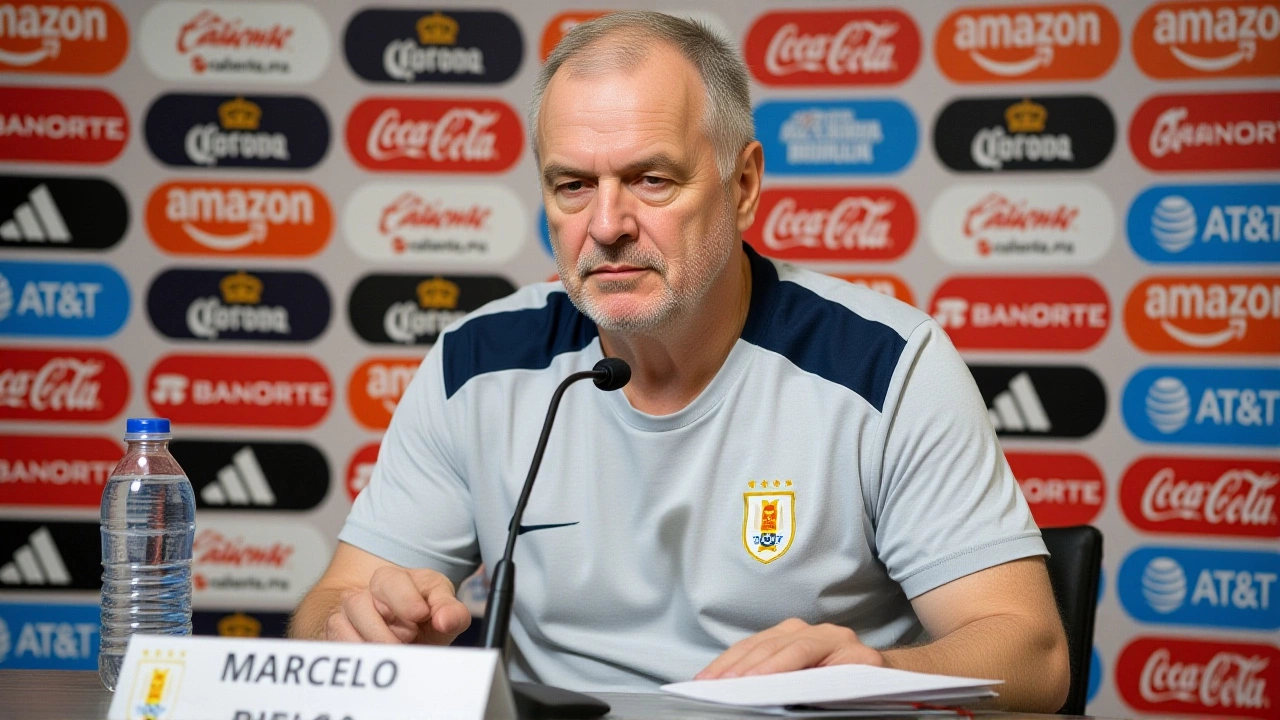
It wasn’t the kind of match that made headlines — no goals, no dramatic comebacks, just two tired teams slugging through 95 minutes of muddy, rain-slicked football in Torreón. But when Mexico vs. Uruguay ended 0-0 on November 15, 2025, it wasn’t just a draw — it was a mirror held up to both squads’ evolving identities. The game, played under a gloomy sky at an unnamed stadium in northern Mexico, left fans frustrated, pundits divided, and coaches with more questions than answers.
What Happened on the Pitch?
The first half was a cautious dance. Mexico started with a 4-2-3-1, featuring Hirving Lozano on the wing and Raúl Jiménez as the lone striker. But Uruguay, without Luis Suárez or Edinson Cavani, looked sharper in transition. Their midfield trio — anchored by Rodrigo Zalazar and Juan Manuel Sanabria — controlled tempo early, until halftime substitutions changed the rhythm. Nahitan Nández and Facundo Torres came on at 45’, injecting pace and creativity. Torres, in particular, became a thorn in Mexico’s defense, cutting inside with surprising agility.Mexico’s best chance came in the 79th minute. A looping cross from the left found Jiménez six yards out — unmarked, in space, with only Santiago Mele to beat. He hesitated. The ball rolled wide. Fox Deportes commentator Rodolfo didn’t hold back: “LOZANO. WE ALL JIMENEZ JUST TOOK IT! HESITATION. THE LAST MAN HE WOULD EXPECT TO MISS... THAT WAS A REAL OPPORTUNITY.”
Then, in the 90+5’ minute, came the final act: Johan Vásquez rose above the pack, connecting with a Gilberto Mora cross. His header was powerful — but Santiago Mele, Uruguay’s 23-year-old backup keeper, stretched full length and palmed it away. The stadium fell silent. No celebration. No groans. Just exhaustion.
A Controversy in the Box
The real drama, though, happened off the ball. In the 88th minute, César Montes tangled with Facundo Torres near the penalty spot. Torres went down. The referee waved play on. Fox Deportes’ Mariano was adamant: “IT WAS A LITTLE BIT OF CONTACT INSIDE OF THE BOX... ROBERT THAT WAS A PENALTY. IT IS A SLIGHT CONTACT. IT IS CLEAR.” Keith, the third commentator, disagreed: “HE LOOKED LIKE IT MIGHT HAVE BEEN A CONTACT. NO PENALTY FOR NOW.”Replays showed Montes’ arm brushed Torres’ hip as both jumped for a loose ball — barely enough to warrant a whistle, but enough to spark debate. It wasn’t a clear penalty. But it wasn’t a clean challenge either. In a match with so little action, that moment became the focal point. Fans online later tagged #PenaltyForTorres on social media. Uruguay’s coach, Diego Alonso, called it “typical of the game’s physicality.” Mexico’s interim manager, Jaime Lozano, simply said: “We didn’t create enough to need penalties.”

Who’s Playing for What?
This wasn’t a World Cup qualifier. It wasn’t even a Nations League match. It was a 2025 International Friendly — part of a global weekend of tune-ups. Mexico was testing new midfield combinations after the departure of Edson Álvarez and the injury to Andrés Guardado. Vásquez, 24, and Érick Sánchez, 22, were given 70+ minutes to prove they could handle the pressure. Lozano, now 29, played the full 90 — his fifth straight start since returning from a knee setback.For Uruguay, it was a scouting mission. With the 2026 World Cup qualifiers looming, coach Alonso used the match to evaluate youth. Torres, 22, and Nández, 27, showed they could step up in the absence of the legendary midfielders. Mele, who’s never started for Uruguay in a competitive match, kept a clean sheet — a rare feat against Mexico’s attacking depth.
Both teams fielded squads filled with fringe players. Mexico’s bench included 12 players, six of whom are under 23. Uruguay’s substitutes list was equally sparse on household names. This wasn’t about winning. It was about finding chemistry.
Why This Matters
On the same day, the USMNT beat Paraguay 2-0 in Pennsylvania. Brazil thrashed Bolivia 4-1. Germany drew 1-1 with Japan. But few noticed Mexico-Uruguay. And yet, this match mattered more than most realize.For Mexico, it exposed a dangerous pattern: they look dangerous on the counter, but struggle to break down organized defenses. Lozano and Jiménez are world-class in isolation — but without midfield support, they’re isolated. The lack of a true playmaker was glaring. Vásquez, who played like a box-to-box warrior, is a good player — but not a creator.
For Uruguay, it confirmed they’re rebuilding. They’re no longer the physical, relentless force of 2010 or 2014. But Torres and Nández suggest a new generation is ready. They’re quicker. More technical. Less reliant on brute force.
The draw means nothing in standings. But it speaks volumes about where both teams stand in 2025. Mexico is in transition. Uruguay is in renewal. Neither is elite right now — but both are trying to find their way back.

What’s Next?
Mexico’s next match is a World Cup qualifier against Costa Rica on March 21, 2026. Uruguay faces Colombia in the same window. Both will likely field stronger lineups — but the lessons from Torreón will linger.For Mexico: Can they develop a midfield that connects defense to attack? Or will they keep relying on individual brilliance that fades under pressure?
For Uruguay: Can their young attackers replicate this form against top-tier opposition? Or was this just a lucky night against a tired defense?
One thing’s clear: football is no longer just about trophies. Sometimes, it’s about finding the right pieces — even if it takes a goalless draw in a quiet stadium in Torreón to see them.
Frequently Asked Questions
Why was the match held in Torreón instead of Mexico City?
Mexico’s federation often rotates friendly venues to expand fan engagement beyond the capital. Torreón, in Coahuila, has hosted international friendlies before — most recently in 2022 against South Korea. The city’s Estadio Corona is smaller (over 40,000 capacity), making it ideal for testing younger players in a more intimate setting, while still drawing a passionate regional crowd.
Who scored the most goals in the 2025 International Friendly series?
As of November 2025, the top scorer was Giovanni Reyna of the USMNT, who netted two goals against Paraguay on the same day as the Mexico-Uruguay match. No player from either Mexico or Uruguay found the net in their friendly. Overall, the 2025 friendly series saw 17 goals scored across 12 matches, with most tallies coming from emerging talents under 23.
Was this match officially recognized by FIFA?
Yes. All international friendlies involving senior national teams are registered under FIFA’s official calendar. The match was listed in FIFA’s Match Calendar as #F25-0187, with both federations submitting official lineups. Though it doesn’t count toward rankings, it does count toward player caps and eligibility for future tournaments.
Why didn’t Mexico use their star players like Chicharito or Jiménez in key moments?
Actually, Raúl Jiménez played the full match — he was the focal point. But Chicharito (Javier Hernández) hasn’t been called up since 2023, having retired from international duty. Mexico’s current squad is deliberately youth-focused, with veterans like Jiménez and Lozano used to mentor younger players like Vásquez and Álvarez. The team is rebuilding around a new core, not relying on past legends.
How did the weather affect the match?
A light rain began in the 25th minute and continued through halftime, turning the pitch slick. This slowed passing and reduced accuracy. Mexico’s usual short-passing game suffered, and Uruguay’s long balls were more effective. The conditions also made it harder for goalkeepers to handle crosses — which explains why Mele’s save in the 90+5’ minute was so crucial. The rain may have been the silent third team.
Will this result impact FIFA rankings?
No. Friendlies have minimal impact on FIFA rankings — only 10 points are awarded for a draw, compared to 30 for a win in a World Cup qualifier. Mexico remains ranked 11th globally, Uruguay at 14th. The result won’t shift either position. But if Mexico continues to play this way in qualifiers, their ranking could drop — which is why this match was more about form than points.
 Sports
Sports